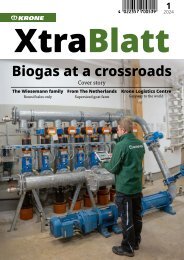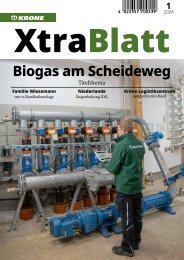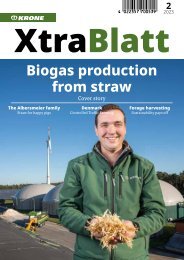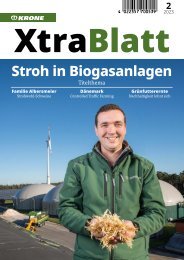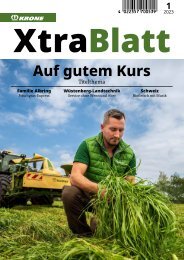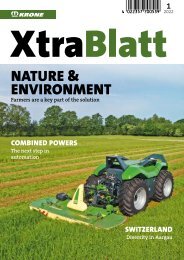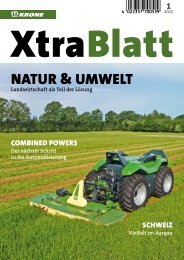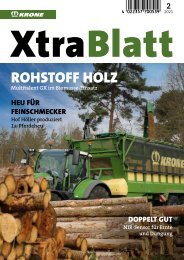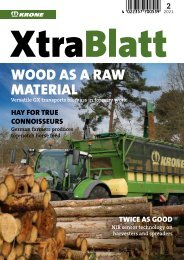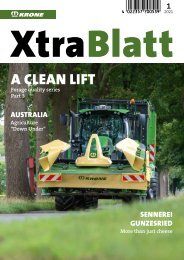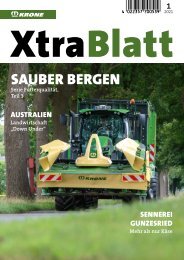XtraBlatt Issue 01-2023
Create successful ePaper yourself
Turn your PDF publications into a flip-book with our unique Google optimized e-Paper software.
THE LAMBRECHT-SPELLER FAMILY<br />
A move away<br />
from slats<br />
to straw<br />
Although the trend for bedding bulls on straw is supported by policymakers<br />
you wouldn’t expect to find it in the German district of Steinfurt<br />
in northern North Rhine-Westphalia. Here the Lambrecht-Speller family<br />
rear Bavarian Simmentals. We visited them to find out more.<br />
O<br />
n the northern tip of the Westphalian region known<br />
as Tecklenburger Land lies the hamlet of Hopsten,<br />
where the Lambrecht-Speller family have farmed for<br />
generations. “In the 1960s we were the first family in<br />
the region to acquire a combine harvester. Soon, more and more<br />
farmers and contractors followed suit, which is why we gave up<br />
contracting,” explains Heiner Lambrecht-Speller, who runs the<br />
farm with his son Alexander and an apprentice. Prior to 2<strong>01</strong>4,<br />
there were up to 1,000 finishing pigs on the farm.<br />
“Yet, due to the many restrictions that have been imposed on<br />
pig farming since that time, this business is no longer profitable<br />
for us. At the time, we also had a beef finishing unit which we<br />
expanded to provide 800 finishing places, making this our<br />
core business,” says Heiner Lambrecht-Speller. In the interests<br />
of animal welfare, the family now use open-sided housing and<br />
has moved from the typical slatted floors to straw bedding.<br />
“Soft bedding is already a legal requirement for calves under six<br />
months old. So we upgraded the entire operation to conform<br />
to husbandry level 3 (the highest welfare standard),” explains<br />
Heiner Lambrecht-Speller. “Our stalls are open but protected<br />
from the wind,” adds his son.<br />
Simmentals from Bavaria<br />
The old pig shed has been given a new lease of life by converting<br />
it into a well-ventilated calf shed. This can accommodate 110<br />
six- to eight-week-old calves per cycle. “The Simmental is our<br />
preferred choice. This dual-purpose breed is very popular in<br />
Bavaria. The bull calves are collected from various dairy farms<br />
and delivered to us by truck,” says Heiner Lambrecht-Speller.<br />
He and his son chose this beef breed because they are gentle<br />
and easy to manage. “Typical beef finishing farms buy in cattle<br />
at the age of six months from beef cattle or suckler cow farmers.<br />
This of course means that the interim rearing costs are passed<br />
on to them, which is something we avoid with our system.<br />
Furthermore, these animals are available only at certain times of<br />
the year, whereas we get regular deliveries of Simmental calves<br />
every ten weeks,” explains Alexander Lambrecht-Speller.<br />
Obviously, the calves don’t get finishing feed right from the<br />
start. “Each calf is fitted with a transponder which allows them<br />
to drink milk from our automatic feeder. By monitoring their<br />
intake digitally, we can spot a sick calf immediately, for example<br />
if it’s drinking very slowly or not taking the full amount. This<br />
monitoring process is very important when you’re dealing<br />
with calves from up to 75 different farms. It takes about three<br />
weeks for their immune system to adjust,” explains Alexander<br />
Lambrecht-Speller. And it takes around one week for the calves<br />
to get used to the automatic feeder. Ground straw, concentrate<br />
and later, silage maize, are gradually introduced to ensure that<br />
the calves also grow into healthy ruminants. At the same time,<br />
the amount of milk is reduced. At around ten to twelve weeks,<br />
the animals are completely weaned and switched to a total mixed<br />
ration (TMR). This consists of rearing feed, grass silage, maize<br />
silage, straw, brewer’s grains and grain maize. Husbandry level<br />
3 prohibits the use of soya as the feed must be 100% GM-free.<br />
The finishing period begins at the age of six months and is divided<br />
into three stages: early, mid and late finishing. During this<br />
period the feeding regime switches to maize silage, grass silage,<br />
brewer’s grains, rapeseed meal, grain maize and – depending<br />
on availability – pressed sugar beet pulp, in varying amounts<br />
according to the respective stage. <br />
18 1|<strong>2023</strong> <strong>XtraBlatt</strong><br />
<strong>XtraBlatt</strong> 1|<strong>2023</strong><br />
19



